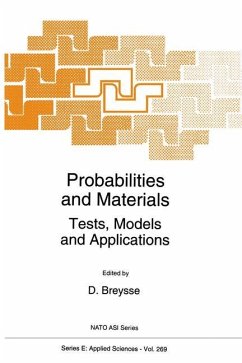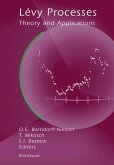Probabilities and Materials
Tests, Models and Applications
Herausgegeben:Breysse, D.
Probabilities and Materials
Tests, Models and Applications
Herausgegeben:Breysse, D.
- Broschiertes Buch
- Merkliste
- Auf die Merkliste
- Bewerten Bewerten
- Teilen
- Produkt teilen
- Produkterinnerung
- Produkterinnerung
Most industrial and natural materials exhibit a macroscopic behaviour which results from the existence of microscale inhomogeneities. The influence of such inhomogeneities is commonly modelled using probabilistic methods. Most of the approaches to the evaluation of the safety of structures according to probabilistic criteria are somewhat scattered, however, and it is time to present such material in a coherent and up-to-date form. Probabilities and Materials undertakes this task, and also defines the great tasks that must be tackled in coming years. For engineers and researchers dealing with…mehr
Andere Kunden interessierten sich auch für
![Lévy Processes Lévy Processes]() Lévy Processes149,99 €
Lévy Processes149,99 €![Nonlinear Stochastic Evolution Problems in Applied Sciences Nonlinear Stochastic Evolution Problems in Applied Sciences]() N. BellomoNonlinear Stochastic Evolution Problems in Applied Sciences39,99 €
N. BellomoNonlinear Stochastic Evolution Problems in Applied Sciences39,99 €![Stochastic Modeling of Microstructures Stochastic Modeling of Microstructures]() Kazimierz SobczykStochastic Modeling of Microstructures38,99 €
Kazimierz SobczykStochastic Modeling of Microstructures38,99 €![Random Evolutions and Their Applications Random Evolutions and Their Applications]() Anatoly SwishchukRandom Evolutions and Their Applications38,99 €
Anatoly SwishchukRandom Evolutions and Their Applications38,99 €![Stochastic Processes in Epidemic Theory Stochastic Processes in Epidemic Theory]() Stochastic Processes in Epidemic Theory38,99 €
Stochastic Processes in Epidemic Theory38,99 €![Stochastic Geometry Stochastic Geometry]() Viktor BenesStochastic Geometry38,99 €
Viktor BenesStochastic Geometry38,99 €![Stochastic Equations and Differential Geometry Stochastic Equations and Differential Geometry]() Ya.I. BelopolskayaStochastic Equations and Differential Geometry39,99 €
Ya.I. BelopolskayaStochastic Equations and Differential Geometry39,99 €-
-
-
Most industrial and natural materials exhibit a macroscopic behaviour which results from the existence of microscale inhomogeneities. The influence of such inhomogeneities is commonly modelled using probabilistic methods. Most of the approaches to the evaluation of the safety of structures according to probabilistic criteria are somewhat scattered, however, and it is time to present such material in a coherent and up-to-date form. Probabilities and Materials undertakes this task, and also defines the great tasks that must be tackled in coming years.
For engineers and researchers dealing with materials, geotechnics, solid mechanics, soil mechanics, statistics and stochastic processes. The expository nature of the book means that no prior knowledge of statistics or probability is required of the reader. The book can thus serve as an excellent introduction to the nature of applied statistics and stochastic modelling.
For engineers and researchers dealing with materials, geotechnics, solid mechanics, soil mechanics, statistics and stochastic processes. The expository nature of the book means that no prior knowledge of statistics or probability is required of the reader. The book can thus serve as an excellent introduction to the nature of applied statistics and stochastic modelling.
Produktdetails
- Produktdetails
- Nato Science Series E: 269
- Verlag: Springer / Springer Netherlands
- Artikelnr. des Verlages: 978-94-010-4500-1
- Softcover reprint of the original 1st edition 1994
- Seitenzahl: 556
- Erscheinungstermin: 13. November 2012
- Englisch
- Abmessung: 240mm x 160mm x 30mm
- Gewicht: 877g
- ISBN-13: 9789401045001
- ISBN-10: 9401045003
- Artikelnr.: 39916293
- Herstellerkennzeichnung
- Springer-Verlag GmbH
- Tiergartenstr. 17
- 69121 Heidelberg
- ProductSafety@springernature.com
- Nato Science Series E: 269
- Verlag: Springer / Springer Netherlands
- Artikelnr. des Verlages: 978-94-010-4500-1
- Softcover reprint of the original 1st edition 1994
- Seitenzahl: 556
- Erscheinungstermin: 13. November 2012
- Englisch
- Abmessung: 240mm x 160mm x 30mm
- Gewicht: 877g
- ISBN-13: 9789401045001
- ISBN-10: 9401045003
- Artikelnr.: 39916293
- Herstellerkennzeichnung
- Springer-Verlag GmbH
- Tiergartenstr. 17
- 69121 Heidelberg
- ProductSafety@springernature.com
to the Workshop.- 1. Synthetic texts by chairmen.- Probability and materials: data subjective and objective modeling A Synthesis paper.- Introductory remarks to Session 2: Tools.- Models: micro-macro. The Synthetic paper.- Failure and probabilities at various scales. A Synthetic paper.- Probabilistic and stochastic models. A Synthetic paper.- Numerical simulations and applications - an introduction.- 2. Data subjective and objective modeling.- Application of probabilistic approaches in geotechnical engineering and engineering geology.- The variability of geotechnical parameters.- Small scale variability in clay samples.- Classification logic and correlation between soils parameters: application to an elasto-plastic law.- Variability of the mechanical properties of wood: randomness and determinism.- Stochastic modeling of lumber properties.- Experimental study on the scale effect on concrete in tension.- 3. Tools.- Fractals, renormalization group theory and scaling laws for strength and toughness of disordered materials.- Size effect and stochastic nonlocal damage in quasibrittle materials.- Role of disorder in brittle fracture.- Blocking problems in the analysis of random fields.- Experimental designs for an experimental modeling of material or structural tests.- Report on the first round table session: tools.- 4. Models: Micro-macro.- Morphological random media for micromechanics.- Effective elastic properties of solids with randomly located defects.- Experimental characterization, mircomechanical simulation and spatio-stochastic approach of concrete behaviours below the representative volume.- Micromechanical model for randomly packed granules.- A Voronoi cell finite element model for random heterogeneous media.- Random stress fields within granular media.-Statistical modeling for the flow of short fibers composites.- Modeling granular fabric by tensors and their statistical test.- 5. Models: cracking and fracture surfaces.- Statistical fracture mechanics - basic concepts and numerical realization.- A stochastic model for controlled discontinuous crack growth in brittle materials.- Crack pattern related universal constants.- Crack growth simulations in concrete and rock.- Report on the second round table session: models for fracture.- 6. Probabilistic failure models.- Probabilistic models and image analysis: tools to describe liquid phase sintered materials.- Probabilistic failure predictions in brittle material under multiaxial loading.- Volume and stress heterogeneity effects in ceramics and fiber reinforced ceramics.- Applicability of a Weibullian model of fracture by application of a slowly gradual load.- A stochastic model to describe probabilistic aspects of damage accumulation in concrete.- 7. Numerical simulations and practical aspects of material modeling.- Stochastic field theory in materials engineering.- Stochastic approaches for damage evolution in quasi-brittle materials.- How to manage the spatial variability of natural soils.- Statistical analysis of the mechanical properties of masonry walls by computational models.- A report on round table 3: applications.
to the Workshop.- 1. Synthetic texts by chairmen.- Probability and materials: data subjective and objective modeling A Synthesis paper.- Introductory remarks to Session 2: Tools.- Models: micro-macro. The Synthetic paper.- Failure and probabilities at various scales. A Synthetic paper.- Probabilistic and stochastic models. A Synthetic paper.- Numerical simulations and applications - an introduction.- 2. Data subjective and objective modeling.- Application of probabilistic approaches in geotechnical engineering and engineering geology.- The variability of geotechnical parameters.- Small scale variability in clay samples.- Classification logic and correlation between soils parameters: application to an elasto-plastic law.- Variability of the mechanical properties of wood: randomness and determinism.- Stochastic modeling of lumber properties.- Experimental study on the scale effect on concrete in tension.- 3. Tools.- Fractals, renormalization group theory and scaling laws for strength and toughness of disordered materials.- Size effect and stochastic nonlocal damage in quasibrittle materials.- Role of disorder in brittle fracture.- Blocking problems in the analysis of random fields.- Experimental designs for an experimental modeling of material or structural tests.- Report on the first round table session: tools.- 4. Models: Micro-macro.- Morphological random media for micromechanics.- Effective elastic properties of solids with randomly located defects.- Experimental characterization, mircomechanical simulation and spatio-stochastic approach of concrete behaviours below the representative volume.- Micromechanical model for randomly packed granules.- A Voronoi cell finite element model for random heterogeneous media.- Random stress fields within granular media.-Statistical modeling for the flow of short fibers composites.- Modeling granular fabric by tensors and their statistical test.- 5. Models: cracking and fracture surfaces.- Statistical fracture mechanics - basic concepts and numerical realization.- A stochastic model for controlled discontinuous crack growth in brittle materials.- Crack pattern related universal constants.- Crack growth simulations in concrete and rock.- Report on the second round table session: models for fracture.- 6. Probabilistic failure models.- Probabilistic models and image analysis: tools to describe liquid phase sintered materials.- Probabilistic failure predictions in brittle material under multiaxial loading.- Volume and stress heterogeneity effects in ceramics and fiber reinforced ceramics.- Applicability of a Weibullian model of fracture by application of a slowly gradual load.- A stochastic model to describe probabilistic aspects of damage accumulation in concrete.- 7. Numerical simulations and practical aspects of material modeling.- Stochastic field theory in materials engineering.- Stochastic approaches for damage evolution in quasi-brittle materials.- How to manage the spatial variability of natural soils.- Statistical analysis of the mechanical properties of masonry walls by computational models.- A report on round table 3: applications.








